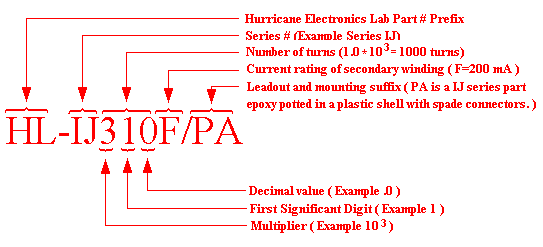1. Determine which part meets your needs. 2. Select the proper MOUNTING OPTIONS and add the proper two digit leadout and mounting suffix to the part number. Contact our engineering department if you need additional help. 3. Call in your order to (435) 635-2003, or send a fax to (435) 635-2495.Our part Number.

Burden Resistors:
In current transformer applications it is necessary to place a burden resistor across the output of the transformer. From a design standpoint the primary function is to limit the output voltage so that the transformer is not allowed to saturate. From a circuit design point of view thje burden resistor is used to adjust the output of the transformer to the desired output for the particular circuit. In reality both of these criteria must be dealt with. Instead of designing current traansformers to operate with a given burden resistor value we suggest the following approach: 1. Select a current transformer that has the mechanical specifications that you need and that is rated to handle your maximum current. 2. Determine the maximum output voltage for the selected part at the frequency you are going to operate at (see example). Use the smaller of this value or the maximum output voltage you need for your application. Let this value be Vmax. If your circuit requires a higher output voltage amplify the output. (Refer to our application note #108). 3. Determine the maximum current that you would like to measure and divide this value by the number of turns in the secondary winding of the current transformer. This is the maximum current that will flow in the secondary. This value is Isecondary. 4. The correct burden resistor is found by dividing Vmax by Isecondary. Example: Using an HL-IH250f/ current transformer to measure current to 100 amps at 60 hz. From the catalog data listing for the HL-IH250F/ the maximum output voltage is 0.40 Volts. 100 Amps divided by 500 turns gives us a value of secondary current of 0.20 Amps. 0.40 Volts divided by 0.20 Amps gives us a value for the burden resistor of 2.0 Ohms. If you want to operate at 400 Hz the maximum output voltage can be calculated using:V400Hz=(400/60)V60Hz. Shifting the above example to 400Hz.
V400Hz=(400/60)0.4=2.66 Volts